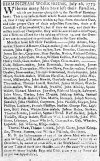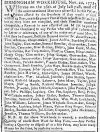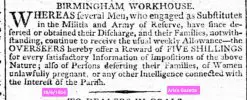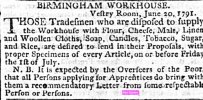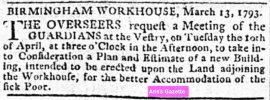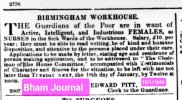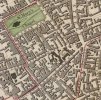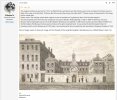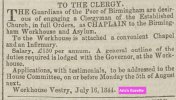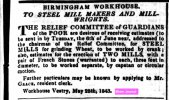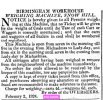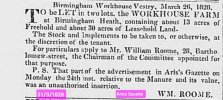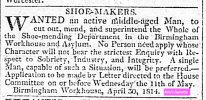Below is the late Peter Walker's information about the early Birmingham Workhouse located between Lichfield Street and Steelhouse Lane (approximately where Coleridge Passage is today).
Origin of the first Workhouse of 1734
During the 18th century, as towns grew and more people moved from farm work, the care of the elderly, infirm, for widows and orphans, who otherwise had no means of support, became an increasing problem for parish councils. Parliamentary Acts were passed to enable parishes to build work-houses, where people could live and do such work as they were fit to do. The Parish of Aston built its workhouse in Erdington as early as 1700, but the first record in Birmingham dates back to 1727 when a minute in the Town Book, signed by 24 persons, recorded that they all "do think it highly necessasry and convenient, and accordingly order, that a publick Work House should be erected in or near the said Town, to employ and set to work the poor of Birmingham aforesaid for their better mauintenance as the Law directs". A private Act of Parliament was passed in 1731, twelve Trustees were appointed, a site was selected in Lichfield Street (later Corporation Street) and a plain but elegant building was erected at a cost of over £1173. 3s 5d. - and opened in 1734. The historian William Hutton described its appearance fifty years later as 'more like a gentleman's residence than a public institution'. An infirmary wing was added on the left-hand side in 1766 costing £400, and workshop wing was added on the right at a cost of £700 in 1779. The accommodation for 600 inmates fully met the requirements at the time. Workhouse Guardians tried to find outside work for their adult inmates, generally without much success, but were given street cleaning and road repair work from time to time. From 1766, the Workhouse Infirmary was the only place in Birmingham where the sick could be attended, until the Birmingham General Hospital in Summer Lane was opened belatedly in 1779.
By 1783 there was serious overcrowding in the workhouse, and plans were prepared for a new and larger building, but nothing much was built for seventy years. However an Asylum for the Infant Poor was opened in Summer Lane in 1797, where boys could learn farming or pin-making, and girls straw-plaiting or domestic work. This was the first attempt to reduce high mortality figures amongst pauper children, and
improve the conditions in which they lived. Other children were boarded out in neighbouring villages. (Source: Extracted from this thread https://birminghamhistory.co.uk/for...ham-workhouse-peter-walker.47028/#post-689682)
A new (second) Birmingham Workhouse was built in Dudley Road/Western Road in 1852. There's a thread about the second workhouse here https://birminghamhistory.co.uk/for...se-dudley-road-western-road-opened-1852.2280/
Some extracts from Aris's Gazette of the time demonstrating how this first workhouse operated, including labour of the poor and apprenticeships

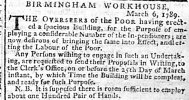
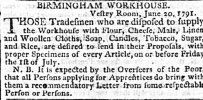

Source: British Newspaper Archive
Origin of the first Workhouse of 1734
During the 18th century, as towns grew and more people moved from farm work, the care of the elderly, infirm, for widows and orphans, who otherwise had no means of support, became an increasing problem for parish councils. Parliamentary Acts were passed to enable parishes to build work-houses, where people could live and do such work as they were fit to do. The Parish of Aston built its workhouse in Erdington as early as 1700, but the first record in Birmingham dates back to 1727 when a minute in the Town Book, signed by 24 persons, recorded that they all "do think it highly necessasry and convenient, and accordingly order, that a publick Work House should be erected in or near the said Town, to employ and set to work the poor of Birmingham aforesaid for their better mauintenance as the Law directs". A private Act of Parliament was passed in 1731, twelve Trustees were appointed, a site was selected in Lichfield Street (later Corporation Street) and a plain but elegant building was erected at a cost of over £1173. 3s 5d. - and opened in 1734. The historian William Hutton described its appearance fifty years later as 'more like a gentleman's residence than a public institution'. An infirmary wing was added on the left-hand side in 1766 costing £400, and workshop wing was added on the right at a cost of £700 in 1779. The accommodation for 600 inmates fully met the requirements at the time. Workhouse Guardians tried to find outside work for their adult inmates, generally without much success, but were given street cleaning and road repair work from time to time. From 1766, the Workhouse Infirmary was the only place in Birmingham where the sick could be attended, until the Birmingham General Hospital in Summer Lane was opened belatedly in 1779.
By 1783 there was serious overcrowding in the workhouse, and plans were prepared for a new and larger building, but nothing much was built for seventy years. However an Asylum for the Infant Poor was opened in Summer Lane in 1797, where boys could learn farming or pin-making, and girls straw-plaiting or domestic work. This was the first attempt to reduce high mortality figures amongst pauper children, and
improve the conditions in which they lived. Other children were boarded out in neighbouring villages. (Source: Extracted from this thread https://birminghamhistory.co.uk/for...ham-workhouse-peter-walker.47028/#post-689682)
A new (second) Birmingham Workhouse was built in Dudley Road/Western Road in 1852. There's a thread about the second workhouse here https://birminghamhistory.co.uk/for...se-dudley-road-western-road-opened-1852.2280/
Some extracts from Aris's Gazette of the time demonstrating how this first workhouse operated, including labour of the poor and apprenticeships




Source: British Newspaper Archive
Last edited:

